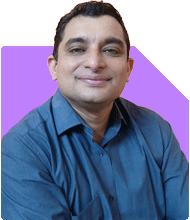Early Signs of Parkinson's: Exercises and Yoga Recommendations for My Wife?
Dr Shakeeb Ahmed Khan | Answer |Ask -Follow
Physiotherapist - Answered on Feb 19, 2025
He has served as a technical consultant for the World Health Organisation, the United Nations, the Tata Institute of Social Sciences and several national and international NGOs.
Besides physiotherapy, he is keenly interested in disability management, early intervention, geriatric care and assisting children with disabilities.
Dr Khan has a bachelor's degree in physiotherapy from the Ravi Nair Physiotherapy College in Wardha, Maharashtra, a master's degree in disability rehabilitation administration from the National Institute for the Mentally Handicapped, Secunderabad, and a PhD in disability management from Bangalore University.... more

My wife is showing early signs pf parkinsons disease, (Left hand tremors). What exercises / yoga is recommended?
Thank you for your query, and I appreciate you reaching out. Sorry to hear about your wife's condition .My response would be from Physiotherapy perspective as Physiotherapy is evidence based and well research and widely accepted management for ensuring person with Parkinson can perform activities of daily living independently and mention few exercises She can practice finger tapping, hand squeezing, wrist rotations, and palm open-close exercises to enhance dexterity. Stretching, shoulder rolls, and posture correction will help reduce stiffness. Balance exercises like weight shifts and tandem walking can improve stability. Parkinson’s requires long-term rehabilitation, so visiting a nearby physiotherapist or arranging a home visit will ensure proper guidance and support. Early intervention is key to better management. Wishing her good health and strength.
You may like to see similar questions and answers below
Radhika Iyer | Answer |Ask -Follow
Yoga Expert - Answered on Jun 20, 2023
Dr Shakeeb Ahmed Khan | Answer |Ask -Follow
Physiotherapist - Answered on Aug 28, 2024
Dr Shakeeb Ahmed Khan | Answer |Ask -Follow
Physiotherapist - Answered on Aug 04, 2025
Ramalingam Kalirajan |10893 Answers |Ask -Follow
Mutual Funds, Financial Planning Expert - Answered on Dec 15, 2025
Ramalingam Kalirajan |10893 Answers |Ask -Follow
Mutual Funds, Financial Planning Expert - Answered on Dec 15, 2025
Radheshyam Zanwar |6746 Answers |Ask -Follow
MHT-CET, IIT-JEE, NEET-UG Expert - Answered on Dec 15, 2025
Ramalingam Kalirajan |10893 Answers |Ask -Follow
Mutual Funds, Financial Planning Expert - Answered on Dec 15, 2025
Ramalingam Kalirajan |10893 Answers |Ask -Follow
Mutual Funds, Financial Planning Expert - Answered on Dec 15, 2025
Ramalingam Kalirajan |10893 Answers |Ask -Follow
Mutual Funds, Financial Planning Expert - Answered on Dec 15, 2025
Samraat Jadhav |2508 Answers |Ask -Follow
Stock Market Expert - Answered on Dec 15, 2025
Ramalingam Kalirajan |10893 Answers |Ask -Follow
Mutual Funds, Financial Planning Expert - Answered on Dec 15, 2025
Reetika Sharma |425 Answers |Ask -Follow
Financial Planner, MF and Insurance Expert - Answered on Dec 15, 2025
Radheshyam Zanwar |6746 Answers |Ask -Follow
MHT-CET, IIT-JEE, NEET-UG Expert - Answered on Dec 15, 2025

























